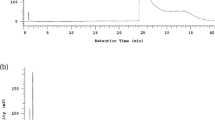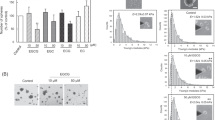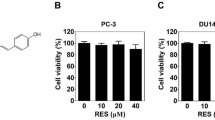Abstract
RRR-α-tocopheryl succinate (α-vitamin E succinate, VES), one of the vitamin E derivatives, can effectively inhibit the proliferation of human prostate cancer cells. However, little is known about its effect on prostate cancer cell invasive ability. Tumor metastasis is a complex process and the extracellular matrix (ECM) is the first barrier that tumor cells encounter. Therefore, we tested the effect of VES on the invasion of different prostate tumor cells, PC-3, DU-145, and LNCaP, through Matrigel, a reconstituted ECM, using an in vitro cell invasion assay. The invasion of PC-3 and DU-145 cells through Matrigel was inhibited by 20 μ M VES after treating for 24 h. The condition did not alter cell survival, cell cycle, cell adhesion or cell motility. We further investigated whether the ability of VES to inhibit prostate cancer cell invasiveness was associated with its ability to inhibit the activity of matrix metalloproteinases (MMPs), the key enzymes in the proteolysis of basement membrane during invasion. PC-3 and DU-145 cells that were treated with VES showed a significant reduction in the levels of MMP-9 in the culture medium. In contrast, LNCaP cells, which did not secrete MMP-9, were poorly invasive in Matrigel and were hardly affected by treatment with VES. This is the first report suggesting that VES inhibits human prostate cancer cell invasiveness and the reduction of secreted MMP-9 activity could be one of the contributory factors, which points to the potential use of VES in the prevention and therapy of prostate cancer invasion.
This is a preview of subscription content, access via your institution
Access options
Subscribe to this journal
Receive 50 print issues and online access
$259.00 per year
only $5.18 per issue
Buy this article
- Purchase on Springer Link
- Instant access to full article PDF
Prices may be subject to local taxes which are calculated during checkout






Similar content being viewed by others
Abbreviations
- ECM:
-
extracellular matrix
- ELISA:
-
enzyme-linked immunoadsorbent assay
- FBS:
-
fetal bovine serum
- FCM:
-
fibroblasts conditioned medium
- MMP:
-
matrix metalloproteinase
- PCR:
-
polymerase chain reaction
- RT:
-
reverse transcription
- s.d.:
-
standard deviation
- SDS–PAGE:
-
sodium dodecyl sulfate polyacrylamide gel electrophoresis
- TIMP:
-
tissue inhibitor of matrix metalloproteinase
- α-VE:
-
α-vitamin E (RRR-α-tocopherol)
- VEA:
-
α-vitamin E acetate (RRR-α-tocopheryl acetate)
- VES:
-
α-vitamin E succinate (RRR-α-tocopheryl succinate)
References
Albini A, Iwamoto Y, Kleinman HK, Martin GR, Aaronson SA, Kozlowski JM and McEwan RN . (1987). Cancer Res., 47, 3239–3245.
Barnett KT, Fokum FD and Malafa MP . (2002). J. Surg. Res., 106, 292–298.
Cheeseman KH, Holley AE, Kelly FJ, Wasil M, Hughes L and Burton G . (1995). Free Radic. Biol. Med., 19, 591–598.
Coussens LM, Fingleton B and Matrisian LM . (2002). Science, 295, 2387–2392.
Denmeade SR and Isaacs JT . (1997). Br. J. Urol., 79 (Suppl 1), 2–7.
Herron GS, Banda MJ, Clark EJ, Gavrilovic J and Werb Z . (1986). J. Biol. Chem., 261, 2814–2818.
Hu YC, Shyr CR, Che W, Mu XM, Kim E and Chang C . (2002). J. Biol. Chem., 277, 33571–33579.
Iwamoto Y and Sugioka Y . (1992). Adv. Exp. Med. Biol., 324, 141–149.
Jemal A, Murray T, Samuels A, Ghafoor A, Ward E and Thun MJ . (2003). CA: Cancer J. Clin., 53, 5–26.
Jiang WG, Puntis MC and Hallett MB . (1994). Br. J. Surg., 81, 1576–1590.
Kampa M, Hatzoglou A, Notas G, Damianaki A, Bakogeorgou E, Gemetzi C, Kouroumalis E, Martin PM and Castanas E . (2000). Nutr. Cancer, 37, 223–233.
Li Y and Sarkar FH . (2002). Cancer Lett., 186, 157–164.
Lokeshwar BL, Selzer MG, Block NL and Gunja-Smith Z . (1993). Cancer Res., 53, 4493–4498.
Nagakawa O, Ogasawara M, Fujii H, Murakami K, Murata J, Fuse H and Saiki I . (1998). Cancer Lett., 133, 27–33.
Ni J, Chen M, Zhang Y, Li R, Huang J and Yeh S . (2003). Biochem. Biophys. Res. Commun., 300, 357–363.
Prasad KN, Kumar B, Yan XD, Hanson AJ and Cole WC . (2003). J. Am. Coll. Nutr., 22, 108–117.
Rasmussen HS and McCann PP . (1997). Pharmacol. Ther., 75, 69–75.
Sokol RJ, Butler-Simon N, Conner C, Heubi JE, Sinatra FR, Suchy FJ, Heyman MB, Perrault J, Rothbaum RJ and Levy J . (1993). Gastroenterology, 104, 1727–1735.
Stearns ME and Wang M . (1996). Invas. Metast., 16, 116–131.
Stephenson RA, Dinney CP, Gohji K, Ordonez NG, Killion JJ and Fidler IJ . (1992). J. Natl. Cancer Inst., 84, 951–957.
Terranova VP, Hujanen ES and Martin GR . (1986). J. Natl. Cancer Inst., 77, 311–316.
The α-tocopherol, Carotene Cancer Prevention Study Group (1994). N. Engl. J. Med., 330, 1029–1035.
Van den Steen PE, Dubois B, Nelissen I, Rudd PM, Dwek RA and Opdenakker G . (2002). Crit. Rev. Biochem. Mol. Biol., 37, 375–536.
Weber T, Lu M, Andera L, Lahm H, Gellert N, Fariss MW, Korinek V, Sattler W, Ucker DS, Terman A, Schroder A, Erl W, Brunk UT, Coffey RJ, Weber C and Neuzil J . (2002). Clin. Cancer Res., 8, 863–869.
Zhang Y, Ni J, Messing EM, Chang E, Yang CR and Yeh S . (2002). Proc. Natl. Acad. Sci. USA, 99, 7408–7413.
Zi X, Zhang J, Agarwal R and Pollak M . (2000). Cancer Res., 60, 5617–5620.
Acknowledgements
We are particularly grateful to Drs Chawnshang Chang and Edward M. Messing for helpful discussions. We also thank Xi Na, Karen Wolf, and Susan R. Schoen for manuscript preparation. This work is partly supported by NIH Grant DK60912.
Author information
Authors and Affiliations
Corresponding author
Rights and permissions
About this article
Cite this article
Zhang, M., Altuwaijri, S. & Yeh, S. RRR-α-tocopheryl succinate inhibits human prostate cancer cell invasiveness. Oncogene 23, 3080–3088 (2004). https://doi.org/10.1038/sj.onc.1207435
Received:
Revised:
Accepted:
Published:
Issue Date:
DOI: https://doi.org/10.1038/sj.onc.1207435
Keywords
This article is cited by
-
Preparation and Evaluation of Liposomes Co-Loaded with Doxorubicin, Phospholipase D Inhibitor 5-Fluoro-2-Indolyl Deschlorohalopemide (FIPI) and D-Alpha Tocopheryl Acid Succinate (α-TOS) for Anti-Metastasis
Nanoscale Research Letters (2019)
-
Targeting matrix metalloproteinases with novel diazepine substituted cinnamic acid derivatives: design, synthesis, in vitro and in silico studies
Chemistry Central Journal (2018)
-
Generation and characterization of a complete null estrogen receptor α mouse using Cre/LoxP technology
Molecular and Cellular Biochemistry (2009)
-
Vitamin E and selenium supplementation and risk of prostate cancer in the Vitamins and lifestyle (VITAL) study cohort
Cancer Causes & Control (2008)
-
Alpha-tocopheryl succinate (α-TOS) modulates human prostate LNCaP xenograft growth and gene expression in BALB/c nude mice fed two levels of dietary soybean oil
European Journal of Nutrition (2007)



